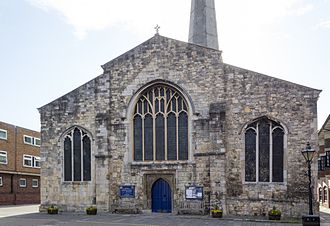<.p>
Placement of this geocache is with kind permission from St Michael's church. Please visit www.stmichaels1070.org.uk for opening times (visiting inside) and other useful information.
,/p> Lesen Sie den Hinweis - read the hint!
This cache was originally placed to celebrate 10 years of Church Micros and reborn just over a year later ~ Thankyou Sadexpolration for the series organisation and Bashful for the statistics
If you enjoyed this cache please award a favourite. St. Michael's Church is the oldest building still in use in the city of Southampton, having been founded in 1070, and is the only church still active of the five originally in the medieval walled town. The church is a Grade I Listed building.
Following the Norman Conquest of England, the town of Southampton was moved west from the original Saxon settlement of Hamwic, around the older St. Mary's Church, to higher ground closer to the River Test. Archaeological evidence has dated the foundation of the church at 1070 and the church was dedicated to St. Michael, patron saint of Normandy. The original church was built on a cruciform plan; the earliest parts of the present Church are the lower storeys of the central tower.
The first documentary evidence of the existence of St. Michael's was in 1160 when Henry II granted the Chapels of St. Michael, Holyrood, St. Lawrence and All Saints to the monks of St. Denys, who retained the patronage until the Dissolution in 1537 when St. Michael's passed to the Crown.
As the town prospered during the Middle Ages, becoming one of the most important ports in England, so did St. Michael's, being at the heart of the thriving medieval town. St. Michael's was enlarged with chapels being added to both sides of the Chancel in the 13th century. During the French raids on the town in October 1338, the church was badly damaged by fire, with the wooden buildings attached to it being completely destroyed. The French raids in the Hundred Years' War and the Black Death damaged the prosperity of the town, and it was not until the end of the 14th century that prosperity returned, with the resumption of the wine trade being evidenced by a large number of wine vaults under the old town streets.

The west door was rebuilt in the 15th century
In the late 14th Century the North Aisle of the church was widened, with the South Aisle being similarly widened and the West Door rebuilt in the 15th Century. Thus the church developed into its present almost rectangular shape. The Church's first spire was constructed in the 15th century and by the beginning of the 16th century, a Chantry Chapel projected from the South Chapel.
From the second half of the 16th century, the importance of Southampton as a port declined, together with the prosperity of the town and the parish of St. Michael. As a result, the fabric of the Church was neglected to such a degree that the chantry chapel was shut off, to be let as a dwelling house and even as a barber's shop until it was pulled down in about 1880.
It was not until 1836 that centuries of neglect were halted, with the newly installed vicar, Rev. T. L. Shapcott embarking upon a major reconstruction, involving new pews, raising the floor level, heightening of the aisles and extension westward of the north aisle, reconstruction of the roof to a lower pitch to bring the whole under one gable, insertion of new galleries to the designs of Francis Goodwin and the replacement of the medieval nave arcades by stuccoed brick and cast-iron pillars, making a slim, elegant contrast to the solid rough stonework of the earlier walls. The whole scheme cost the parish £2,390.
In 1872, the Goodwin galleries had to be removed as they were damaging the fabric of the building.
The spire was first built in the 15th century and reconstructed in 1732. In 1887, to make it a better landmark for shipping, a further 9 ft was added to the blunt shape, bringing it to its present graceful proportions. It is now 165 ft (50 m) high.
In World War II, much of Southampton was devastated by enemy bombing during the blitz. Although the other churches in the central town, Holyrood and All Saints, were both destroyed in 1940, St. Michael's escaped with only minor damage, allegedly because the spire was used by the German bombers as a landmark and their pilots were ordered not to hit it.
In the 1960s, the entire church was restored at a total cost of £36,000, with the work being completed in time for the church's 900th anniversary in 1970.
****************** ********************
For full information on how you can expand the Church Micro series by sadexploration please read the Place your own Church Micro page before you contact him at churchmicro.co.uk
See also the Church Micro Statistics and Home pages for further information about the series.
****************** *******************